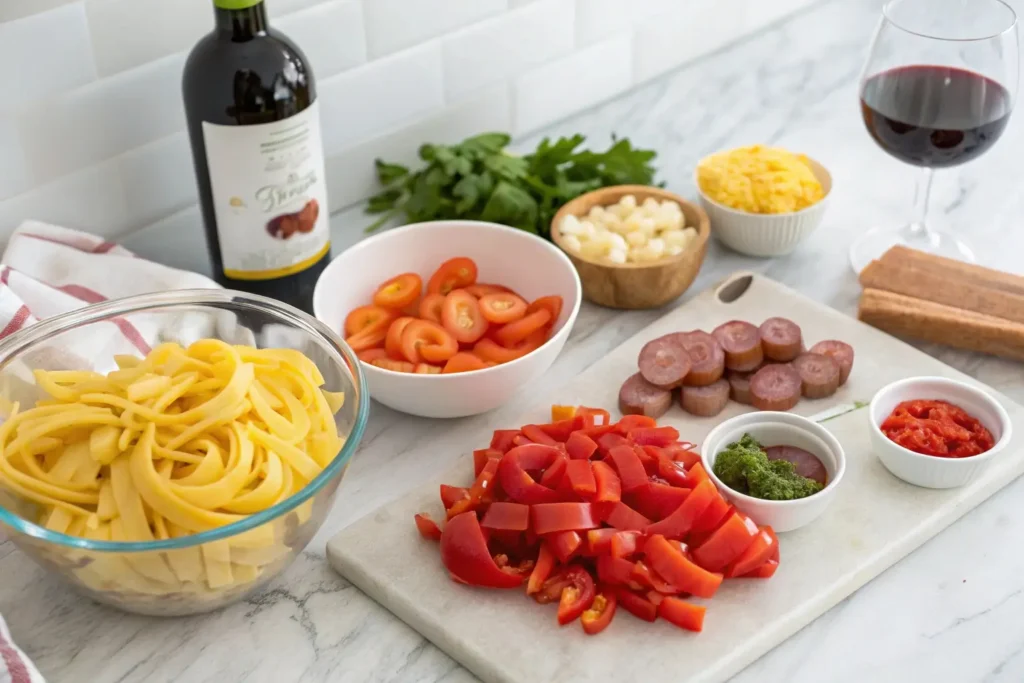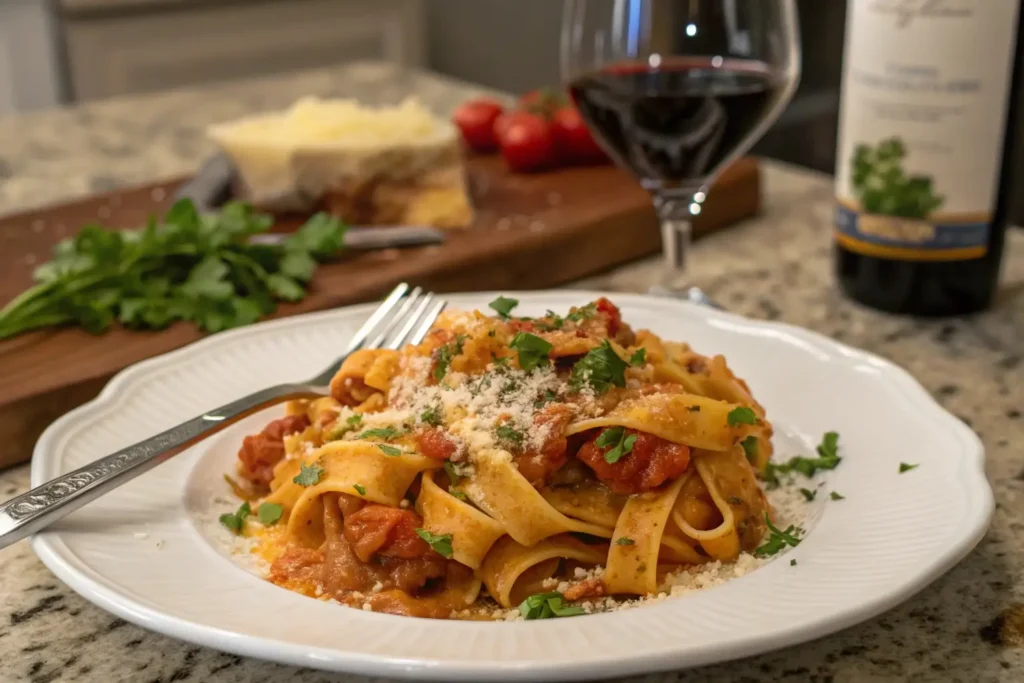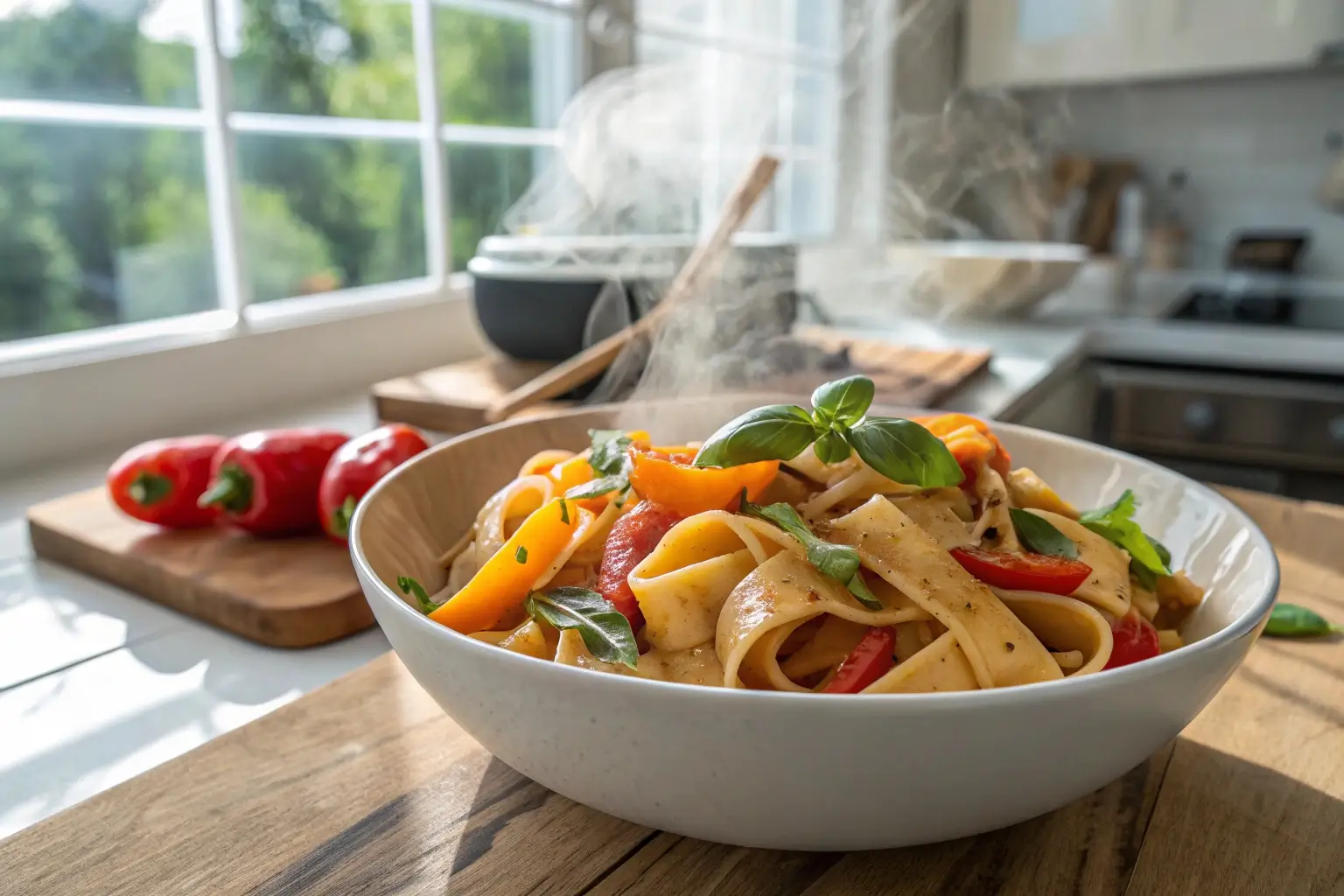Italian Drunken Noodles: A Delicious Fusion Recipe
Italian drunken noodles are the perfect marriage of bold Italian flavors and the vibrant zest of Thai-inspired cooking. This unique recipe blends classic Italian ingredients like pappardelle noodles, spicy sausage, and a tomato-wine sauce with the essence of a beloved Thai dish. Whether you’re a fan of fusion food or simply looking for a creative way to spice up your pasta game, this recipe promises to deliver.
In this article, we’ll dive deep into every aspect of this mouthwatering dish. From its origins and the ingredients that make it shine to its step-by-step preparation and creative variations, there’s something here for every cook. Let’s start by uncovering what makes Italian drunken noodles such a standout recipe!
Introduction to Italian Drunken Noodles
What Are Italian Drunken Noodles?
At its heart, Italian drunken noodles are a fusion dish, combining the spirit of Thai drunken noodles (pad kee mao) with traditional Italian flavors. While the Thai version is known for its savory soy-based sauce and broad rice noodles, this Italian twist brings in hearty pappardelle noodles and a tomato-and-wine sauce that exudes warmth and richness.
The “drunken” part of the name? That comes from the splash of white or red wine in the sauce. It’s not just for show; the wine lends a subtle acidity and depth, transforming a simple dish into something extraordinary.
Origins and Inspiration Behind the Dish
The recipe was born from a love of both cuisines—Thai and Italian. Fusion recipes like this one take the best elements of two culinary worlds and create something new yet familiar. By swapping Thai basil for Italian herbs, spicy sausage for shrimp or tofu, and a tomato-based sauce for soy, this dish retains the spirit of its Thai inspiration while standing tall as a distinctly Italian creation.
Why You’ll Love This Fusion Recipe
There’s something irresistible about the combination of tender noodles, bold spices, and a sauce that’s both tangy and savory. This recipe is perfect for weeknight dinners because it’s quick, customizable, and packed with vibrant flavors. Plus, it’s a conversation starter—a dish that feels fancy but is surprisingly easy to prepare.
The Ingredients That Make It Unique

Key Components: Pappardelle Noodles and Italian Sausage
At the core of Italian drunken noodles are the wide, ribbon-like pappardelle noodles. These egg-based noodles are perfect for soaking up the flavorful tomato-and-wine sauce, offering a soft, chewy texture that balances the dish’s bold components. While other pasta types could work in a pinch, pappardelle’s broad surface area makes it a standout choice for this recipe.
The spicy Italian sausage is another crucial element. With its rich, robust flavor, it adds a hearty base and complements the sweetness of the bell peppers. Whether crumbled or sliced, the sausage provides a slightly smoky, spicy kick that gives this dish its Italian flair.
Tomato Base and Wine: Adding the “Drunken” Element
No fusion dish is complete without a creative twist, and for Italian drunken noodles, it’s the tomato-wine sauce. A generous splash of white or red wine not only adds depth and brightness to the sauce but also earns the dish its “drunken” title. When simmered with garlic, onions, and Italian seasoning, the sauce develops a rich complexity that pairs beautifully with the noodles and sausage.
Fresh Herbs: Basil and Parsley as Flavor Enhancers
Italian dishes often rely on fresh herbs to elevate their flavor profiles, and this recipe is no exception. Chopped parsley and julienned basil not only add vibrant color but also balance the dish’s richness with a hint of earthiness and spice. The aroma alone is enough to whet your appetite!
Colorful Bell Peppers: Aesthetic and Flavor Impact
The tri-color medley of red, yellow, and orange bell peppers does more than brighten the dish visually. Their natural sweetness balances the savory elements, creating a harmony of flavors in every bite. Plus, their crisp texture offers a pleasant contrast to the tender noodles.
Step-by-Step Preparation Guide
Preparing the Pappardelle Noodles
Start by boiling a large pot of salted water. Cook the pappardelle noodles according to the package instructions, ensuring they’re al dente. Drain them well and toss with a drizzle of olive oil to prevent sticking while you prepare the sauce.
Cooking the Spicy Italian Sausage
In a heavy-bottomed pan, heat a bit of olive oil over medium-high heat. Add the sausage, crumbling it into bite-sized pieces. Cook until browned and fully cooked through, then transfer to a plate, leaving the flavorful drippings behind.
Creating the Flavorful Sauce: Onions, Garlic, and Wine
Using the same pan, add sliced onions and sauté until caramelized, about 5 minutes. Sprinkle in Italian seasoning and a pinch of salt for flavor. Next, toss in minced garlic and let it cook for 30 seconds—just long enough to release its aroma. Deglaze the pan with white wine, scraping up any browned bits from the bottom. Allow the wine to reduce slightly before adding canned diced tomatoes, including their juice.
Combining and Tossing: Bringing Everything Together
Return the cooked sausage to the pan, stirring it into the sauce. Let everything simmer gently for 5–7 minutes, allowing the flavors to meld. Add the drained pappardelle noodles directly to the sauce, tossing them with tongs to ensure they’re evenly coated. Sprinkle in half the basil and parsley, saving the rest for garnish.
Variations and Customizations
Making It Vegetarian or Vegan-Friendly
If you’re craving Italian drunken noodles but prefer a plant-based option, there are easy swaps to make it vegetarian or vegan. Instead of Italian sausage, use a plant-based sausage crumble or a savory tofu alternative. Both options absorb the sauce beautifully and keep the dish hearty. For a vegan version, ensure the pappardelle noodles are egg-free or substitute with wide rice noodles or another vegan-friendly pasta.
You can also amp up the vegetable content by adding mushrooms, zucchini, or spinach. These ingredients add both flavor and nutrition, making the dish satisfying and wholesome.
Alcohol-Free Alternatives
Not a fan of cooking with wine? No problem! You can replace the wine with vegetable or chicken stock. To replicate the bright acidity wine brings, squeeze in a bit of fresh lemon juice or add a splash of apple cider vinegar at the end. This tweak ensures the sauce remains vibrant and flavorful without the alcohol.
Alternative Protein Options: Chicken, Shrimp, or Tofu
If spicy sausage isn’t your thing, you can substitute with grilled chicken strips or shrimp for a lighter, leaner option. Simply cook the protein separately and toss it in with the sauce. For a fusion twist that sticks closer to the Thai inspiration, cubed tofu or seared tempeh works beautifully as well. These choices let you adapt the dish to suit various preferences or dietary needs.
Serving and Pairing Suggestions

Best Ways to Serve Italian Drunken Noodles
Italian drunken noodles shine best when served fresh and piping hot. Use a large bowl to showcase the vibrant colors of the peppers, herbs, and noodles. For a touch of indulgence, sprinkle freshly grated Parmesan on top or drizzle with extra virgin olive oil. The result is a visually stunning and irresistibly aromatic dish.
Wine Pairings: White or Red?
The inclusion of wine in the sauce opens the door for exciting pairings. If you used white wine, pair the dish with a crisp Chardonnay or Pinot Grigio. For red wine lovers, a medium-bodied Sangiovese or Merlot complements the sausage and tomato base wonderfully.
Adding Garnishes: Parmesan, Olive Oil, or Cracked Pepper
Garnishes can elevate the final presentation. A sprinkle of cracked black pepper adds a gentle kick, while a handful of fresh parsley or basil leaves brightens the dish. For an extra Italian touch, top it with thin slices of garlic bread on the side, perfect for scooping up that savory sauce.
For more delicious fusion recipes, check out this simple Asian recipe roundup for fresh ideas!
FAQs About Italian Drunken Noodles
What Makes Drunken Noodles “Drunken”?
The “drunken” element in Italian drunken noodles refers to the addition of wine to the sauce. Just like the Thai version, which often has a bold, spicy sauce meant to be paired with beer or other drinks, the Italian twist uses wine to enhance the dish’s flavor profile. The alcohol cooks off during the process, leaving behind a rich, tangy depth.
Why Is It Called Italian Drunken Noodles?
This dish takes its name from its Thai inspiration, pad kee mao, also known as drunken noodles. While the original features broad rice noodles and a spicy soy-based sauce, the Italian version swaps in pappardelle noodles and a tomato-and-wine base. The “drunken” moniker nods to the playful addition of wine and the vibrant, bold flavors that make it irresistible.
What Is the Real Name for Drunken Noodles?
In Thai cuisine, drunken noodles are traditionally called pad kee mao, which translates to “drunken stir-fry.” The Italian adaptation doesn’t have a traditional name, but “Italian drunken noodles” captures its essence perfectly—a fusion dish with a boozy twist.
What Is the Difference Between Egg Noodles and Italian Noodles?
Egg noodles are a broad category of pasta made with eggs and flour, commonly used in various global cuisines. Pappardelle, the noodle of choice in Italian drunken noodles, is a type of Italian egg noodle known for its wide, flat shape. Compared to other egg noodles, pappardelle is heartier and ideal for soaking up thick, flavorful sauces like the tomato-wine base in this recipe.
Exploring Similar Recipes and Culinary Ideas
Other Fusion Dishes to Try
If Italian drunken noodles have whetted your appetite for fusion cuisine, there are plenty of other recipes to explore. Why not try a Mediterranean twist on stir-fried noodles or a creamy Thai-inspired carbonara? These dishes blend the best of multiple cuisines, creating unique flavors that satisfy adventurous palates.
Incorporating Thai and Italian Techniques in Other Recipes
Both Thai and Italian cuisines rely on fresh ingredients, bold spices, and balance in their dishes. Use this principle to create your own fusion recipes. For instance, substitute Italian herbs like oregano and parsley into a Thai curry or add a touch of coconut milk to an Italian risotto. These small tweaks can lead to exciting new creations.
For more recipe inspiration, check out these ideas for rising fusion recipes. Let your culinary creativity shine!
Health and Nutritional Benefits of Italian Drunken Noodles
Nutritional Highlights of Key Ingredients
Italian drunken noodles bring a healthy mix of flavors and nutrients to the table. The pappardelle noodles provide a satisfying source of carbohydrates, which fuel energy and endurance. Adding fresh vegetables, like colorful bell peppers, boosts the dish with vitamin C and antioxidants, promoting overall health and immunity.
The spicy Italian sausage contributes protein and iron, although leaner options like chicken or plant-based sausage can make the dish lighter. Herbs like basil and parsley aren’t just garnish—they’re nutrient powerhouses rich in vitamins K and A.
Nutritional Content (Per 100g)
Below is the approximate nutritional breakdown of Italian drunken noodles. Please note that values may vary depending on specific ingredients and quantities used:
| Nutrient | Amount (Per 100g) |
|---|---|
| Calories | 165 kcal |
| Protein | 7 g |
| Carbohydrates | 20 g |
| Fat | 6 g |
| Saturated Fat | 2 g |
| Fiber | 2 g |
| Sodium | 300 mg |
| Vitamin C | 25 mg |
| Iron | 1 mg |
Adjusting for Dietary Goals
This dish is versatile enough to meet various dietary needs. Swapping regular pasta for whole-grain or gluten-free options can increase fiber content and cater to gluten sensitivities. For calorie-conscious eaters, reducing the sausage portion or choosing low-fat alternatives can significantly cut down on fat while keeping the dish flavorful.
Want a vegetarian twist? Replace sausage with lentils or chickpeas for a protein-packed, heart-healthy version. With small adjustments, Italian drunken noodles can fit into almost any lifestyle without compromising on taste.
Tips for Perfecting Italian Drunken Noodles
Cooking the Noodles to Perfection
One of the most crucial steps in making Italian drunken noodles is ensuring the pappardelle noodles are cooked al dente. Overcooking can lead to mushy noodles that fail to hold the sauce. Always follow the package instructions and toss cooked noodles with olive oil to prevent sticking.
Building Flavorful Layers in the Sauce
To create a rich, layered sauce, start by caramelizing the onions. This step adds natural sweetness and depth. Deglazing the pan with wine not only enhances the flavor but also picks up the browned bits from the sausage, ensuring no flavor is wasted.
Mastering the Balance of Ingredients
The beauty of this recipe lies in its balance—spicy, savory, and slightly tangy. Taste the sauce as you cook, adjusting salt, pepper, and herbs to suit your palate. For added brightness, a splash of lemon juice at the end can elevate the flavors even further.
Cooking at a relaxed pace and savoring the process will ensure your Italian drunken noodles turn out perfect every time!

